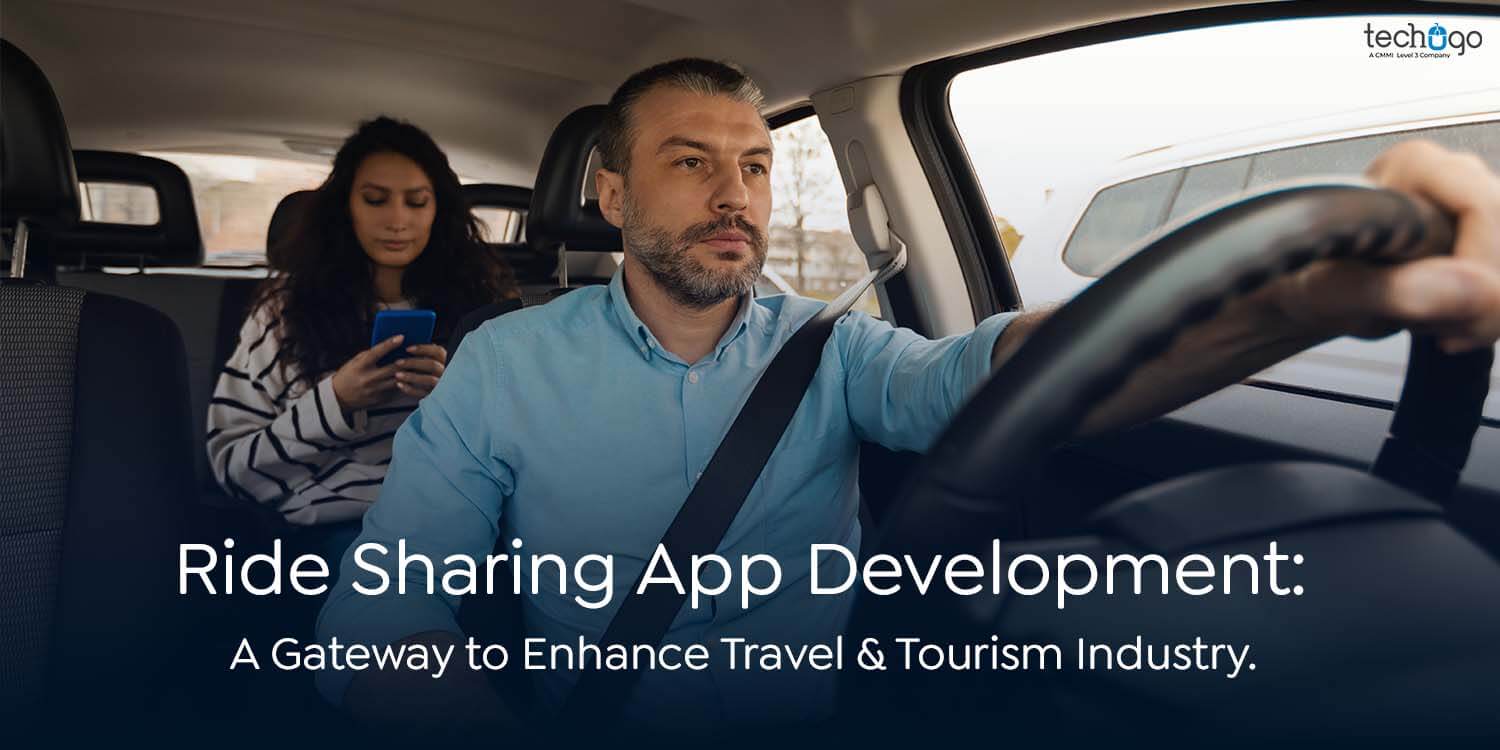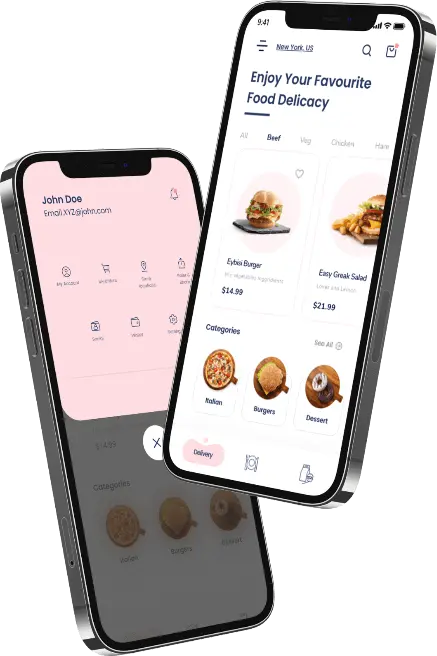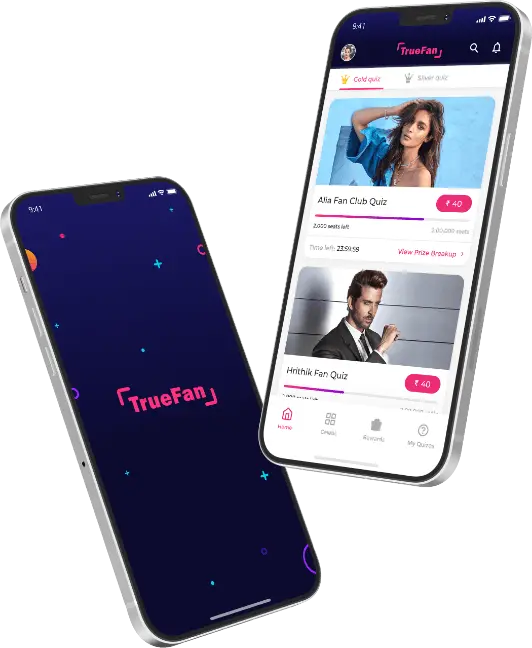6 Feb 2023
Ride Sharing App Development: A Gateway to Enhance Travel & Tourism Industry
Shivani Singh

You are here because you want to build a rideshare app and join other business owners in this growing market.
It’s not surprising, as the market value for international ridesharing apps is expected to rise from $85.8 million in 2021 to $185.1 million by 2026, according to MarketsandMarkets.
However, it isn’t easy to grab the market because of the many powerful companies already ruling the industry, like Uber, Lyft, and Grab.
Many fundamental steps are required to create ridesharing apps that are unique and effective. This includes conducting market research, selecting key features, and estimating costs.
There must be two panels, one for riders/passengers and another for drivers. This divides the fundamental elements required to build a rideshare management app.
Many factors affect the estimated cost of developing an app like this. This calculation is based on the essential features required to build a functional MVP (minimum viable products).
Prices will vary depending on where you are located.
This article will discuss the features you need to include when working with a mobile app development company in USA such as Techugo to build a rideshare app.
We will also be learning about the different parts of the development process, including the necessary tech stacks and platforms. Also, examine the cost of ride sharing app development. So, let’s get started.
Also Read – How Much Does It Cost to Develop a Mobile App?
What is Ridesharing?
A ridesharing service allows passengers to find one-way rides quickly.
The sharing economy’s most important aspect is how technology connects service or product owners and consumers.
The sharing economy model facilitates interactions between individuals, unlike the traditional model, where private companies have equipment.
Drivers are car owners who use the ridesharing business model. They are not registered with taxi companies. Drivers are often independent contractors. Rideshare companies do not withhold taxes from drivers’ wages, allow flexible hours and permit drivers to work overtime.
Uber is the dominant ridesharing mobile app development company in the world, accounting for 37.2% of the global market share in 2019.
DiDi is second with a 32.4% market share.
“Ridesharing” refers to passengers riding with a driver to a specific destination.
Only a handful of passengers use this feature.
Overview of the Ridesharing Marketplace
Between 2020 and 2021, the global ridesharing market grew by more than 50%. This is due to several factors: the cost of a car and the additional driver fees associated with its maintenance and parking are the main reasons why the younger generation has stopped buying a vehicle.
Ridesharing will become more prevalent in areas where car ownership is costly and less practical due to traffic jams or limited parking.
Interesting fact: New York has held for many years the title of the most expensive place with ridesharing options despite growing demand.
Since 2018, New York’s governing council has provided a limited number of cars. A rideshare driver for Uber, Lyft, and other ridesharing companies earns $17.22 an hour to deliver their services. This is an excellent way to protect your driver’s salary.
Experts predict the global ridesharing market could reach $218 billion by 2025. This strong growth will occur on every continent except Antarctica.
- North America
- Europe
- Asia Pacific
By 2025, the annual ridesharing market will grow by more than 30%-35%.
Trends and Future Outlook for the Ridesharing Industry
The ridesharing sector has been able to expand due to the rapid pace of technological innovation and new technologies. Individuals who want to avoid the danger of COVID-19 also saw ridesharing as an alternative to public transportation, which was more congested and made it difficult to disengage from their homes. This section will discuss the current trends and future outlook for ridesharing.
1. Reliability, Safety, and Health are the most critical aspects of our business
The Covid-19 epidemic in the ridesharing industry has caused operational disruption. Customers are changing their travel and psychological habits. Ridesharing companies must assess the emotional and psychological changes in customers’ sentiments and emotions regarding safety, security, and hygiene.
Ridesharing companies have increased their relationships with healthcare providers to reduce the chance of contracting the disease. Other features include enhanced ventilation and a plexiglass partition to separate passengers. Although wearing masks is mandatory at all times, it has been made easier to maintain a robust cleaning schedule.
2. Transition to Sustainable Transportation
Shared trips are a popular choice for ride-hailing companies. Taxis are becoming more popular as a convenient and faster way for commuters to get around. It is becoming increasingly clear that shared, agile taxis are preferred in densely populated areas. This helps reduce traffic congestion and provides a sustainable, city-friendly product. Many ridesharing companies, such as Uber and Lyft, use shared mobility principles developed by international NGOs to create livable cities.
Also read- EVERY BITS AND PIECES OF TAXI APP DEVELOPMENT
3. Electrification of the Ridesharing Fleet
In the future, electric vehicles will be a popular trend in ridesharing fleets. Uber and other companies have begun to explore electric vehicles as a market segment. Electrification of ridesharing can reduce pollution, lower vehicle maintenance costs, and, most importantly, lessen our dependence on fossil fuels.
4. Auto-driving cars
Self-driving cars will also increase as ridesharing companies will soon operate entirely autonomously. This is especially true considering the current number of self-driving vehicles in development. In the future, Lyft, Uber, and Waymo will operate independently of drivers.
5. Connected and autonomous vehicles
According to reports, 54 million connected cars will be on the roads by 2022. These cars will have internet connectivity and communicate with infrastructure such as traffic lights and stop signs. This will increase safety.
Rider-sharing apps are targeted at a specific audience
The ridesharing market is overgrowing and has gained traction. However, the adoption rates vary depending on age, income, and education. Take, for example:
- Millennials are people born between the mid-1990s and mid-2000s (generation Z), are tech-savvy, and can access the internet via their smartphones. They have greater access to ridesharing apps and mobility services. The younger generation is more aware of the benefits associated with ridesharing. They are therefore expected to continue using these services long after they retire.
- It was also found that 70% of those who live in cities with a yearly income of $75,000 or higher are more likely to use ridesharing services instead of slower and more congested modes. Additionally, Americans with higher education use ridesharing services.
- Statistics show that 55% of post-university graduates use Lyft or Uber, compared to 55% for those with fewer qualifications. There are also significant urban-rural disparities. This is because most of those with higher education live within urban areas with access to ridesharing services.
Uber App Features for Riders
There are a few components to the Uber app. One of these parts is the app for end-users. So, let’s look at the key features that make Uber the leader in the global ridesharing market.
1. Book a ride now or later
This is the core feature all Uber apps must have. This feature allows users to book a ride now and for a future trip.
Multiple features combine to provide the necessary capabilities for the ‘book a Ride’ functionality. The following information must be provided before the ride can be booked:
- The pickup address
- Drop-off Location
- The type of vehicle preferred by users
- The time and date (for a book feature)
2. Drivers can be tracked in real-time
Uber solved the problem of traditional taxis by allowing users to see when their driver arrives at the pickup location. With GPS integration, the app will enable users to track drivers in real-time. Uber uses GPS extensively and has many features that depend on this technology.
This feature saves drivers and users in difficult situations where drivers cannot find the required locations. Instead, they can be guided by text messages or calls based on their place on the app map.
Also Read – How To Build A Gps Navigation App That Stands Out In The Market?
3. Real-time ride tracking sharing
Uber is very serious about safety. Uber has a handy feature that allows users to track their drivers in real-time. In addition, this feature will enable friends and family to follow their Uber drivers in real time. This feature is designed to make Uber users feel safer when using Uber in unfamiliar cities or locations.
Once users have reached their destination, they can notify their friends that they are safe. This is an important feature to consider when developing taxi apps.
4. Split the Fare
Uber riders can share the cost of riding with others. Uber charges all credit cards equally and charges a small transaction fee. Split Fare is a better option for customers because they don’t need to pay cash.
5. Multiple drop-off locations
You can also choose multiple drop-off points when you travel with friends. Users can add various drop-off locations to their rides. In addition, you can change your route and add or remove drop-off points. The Fare can also be adjusted automatically as a result.
6. Multiple payment options
You can make your users’ experience better by offering more payment options. For example, Uber allows you to pay online or offline. You can use cash, a credit card, or a mobile wallet to pay for your Uber ride. This feature is crucial for a clone of Uber.
7. Preferred driver
Uber is a popular app many riders use to commute to work and home at night. However, after a few rides, riders tend to develop driver preferences. Consider this essential feature of Uber to build a ridesharing app.
The app allows passengers to share their preferences during the ride-booking process. In addition, the app will assign the ride to the driver if the driver is available.
8. Driver rating and review
Uber should include rating and reviews functionality in its app features list. Uber app users who have had a ride with a driver should be able to rate their experience and give feedback about the driver.
Other users will use this information to help them decide whether or not to book a ride for a driver. The mobile app uses these reviews to identify drivers who provide the best service and those that could be improved.
9. Trip history
Uber’s app includes trip history. This information allows riders to view their trip history, see how much they paid for a ride, how many times they took rides over some time, what kind of experience they had, and to which destination they travelled.
10. Destinations that are currently on sale
Habits are a part of human nature. They will often go to the same place. To book a ride, the user must enter the name of their destination in the Uber app. Uber app features make it easier to save locations for quicker rider bookings in the future. You can also add custom names to places like homes, offices, or gyms.
11. Call or chat in-app
The Uber app should include messaging. Users may need to contact drivers in certain situations to find their pickup location or for information about their whereabouts. It’s possible to do so via the in-app chat and call option.
Consider adding chat to the customer support team or setting up a chatbot to help users with their most common questions.
12. Calendar Shortcuts allows you to sync meetings
Uber users can sync their calendars to the app. This will enable users to add shortcuts to all sessions with an address in the Uber app. This feature has the crucial benefit of a simplified process for booking rides.
13. Press the panic button
This feature is essential if you want your Uber riders to feel safe. Moreover, this feature allows users to alert their loved ones about any emergency that may have occurred while riding or to contact customer service in the event of a dangerous situation.
Uber App for Drivers – Features
You will need to develop an Uber driver app. You have to serve customers and drivers and meet their needs.
This section will cover some Uber driver-facing features.
1. Profile management
Let’s begin with the basics of Uber. Drivers can create and manage their profiles, including adding and changing details about their vehicles, changing passwords, updating personal information, and uploading documents like their driver’s licenses.
2. Earnings
The Earnings panel gives drivers information about how much they have made using an app like Uber. You can filter the data to display daily, weekly, or monthly earnings.
3. Auto off when it is not in use
Drivers who are not online automatically change their status from offline to active when idle.
4. Navigation
All the information drivers need to reach their passenger’s location is available to them right from the ridesharing app. Integrating with Google Maps makes finding and getting real-time route instructions easy.
5. Cancel the trip
Drivers must be able to cancel trips for any reason. Your app can allow you to add other options, such as trip cancellation due to the wrong address or being too far away.
6. Pick-ups at preferred destinations
This feature is great to have in Uber’s app. This feature allows riders to pick up items or get rides on their route while driving home. Once they have entered their location, they can be connected to riders looking for riders near them.
App administrators should add limits to prevent drivers from utilizing the feature in an abusive manner.
7. Taxi-hailing
Drivers may be able to pick up riders who have taxi curbsides. So taxi-hailing will enable them to make extra money, and you won’t lose any revenue.
8. Working hours are limited
You must be mindful of safety when creating an app like Uber. Uber’s limited working hours are one of its features that supports a safe working environment for drivers.
You can limit drivers to 10 hours per week, for example. Drivers who reach the 10-hour mark will automatically be signed out of the app after 8 hours. Drivers will be able to sign back into the app after the cycle has ended, or they will be signed in automatically.
9. Daily summary report
Drivers can see reports at the end to gain insight into their day and find ways to increase their income via the app. These reports may include information such as the duration of work, earnings, distance covered, and tips.
10. Rating and review of riders
Drivers can rate the rider’s experience and leave feedback after they have completed a ride. This information will allow other drivers to view it and decide whether or not to accept ride requests. But drivers are not the only ones who should feel at ease while using your app.
You can ban riders from your application if you notice their behavior is dangerous or unprofessional. Riders and their behavior are also subject to the same rules.
Admin Uber App Features
Apps that provide taxi services include an admin panel. The app’s admins manage drivers and users, provide insights into revenue, and oversee the operation of the entire app.
Below are some features of Uber’s app that can be used to create admin dashboards.
1. Scheduled requests
Administrators can access all scheduled requests, including pick-up location, destination, and selected payment method.
2. Status of the driver
Administrators can view driver statuses online and offline. This feature will enable you to estimate the number of drivers working simultaneously.
3. User reviews
Administrators can review and rate riders and drivers. Administrators can block drivers and riders if they see reviews describing their inappropriate or dangerous behavior.
4. Tracking of drivers
GPS services allow admins to track all drivers and their details. For example, you can track drivers by country or all active drivers worldwide. This information should include the driver’s current location on Google Maps, along with the provider name, rating, car type, and current status.
5. Menu for Partners
Taxi business administrators should be able to add or delete partners and view all details about partners, such as email, contact information, names, and email.
6. Type of service
Administrators should be able to add vehicle types to offer passengers a wider variety of services. Administrators should also be able to modify the names and descriptions of services and enable or disable them temporarily or permanently.
7. Countries
Administrators should have the ability to add or configure countries. This includes adding new countries, editing them, setting up the currency, bonus for users, referrals, etc.
8. Earnings
Administrators can view earnings reports, filter data using different parameters, and see total trips, most profitable drivers, and their details.
Safety Uber App Features
The safety of riders and drivers is the primary concern with ridesharing services. However, you can take control of the situation and reduce any dangers.
1. Trusted contacts
This feature allows users to add their closest friends to Trusted Contracts. These people can access ride details and share them with the user.
2. Profile of the driver
Riders can view driver profiles, including ratings and reviews. They can also see details about the driver, such as a photograph and how many trips they have completed. This information will help them decide whether or not to drive the car.
3. Speed limit alerts
The app flashes visual reminders when a driver nears the speed limit to remind them to keep their speed under control.
4. 24/7 customer support
Additional safety measures include 24/7 customer support. Drivers and passengers can ask questions, report accidents, and receive any assistance they may need.
5. Real-time ID check
Uber-like apps may require drivers to take selfies to verify their identities and ensure they drive the right car regularly.
6. Phone number anonymization
We mentioned that messages and call sharing don’t give out personal numbers. Both drivers’ and riders’ details are protected.
7. Assistance in an emergency
Users can press a single button to call emergency services from their app in an emergency.
8. GPS tracking
The app must track each rider from start to end. The app can access all information to recover the ride’s events if something happens.
9. 2-way rating
Uber’s two-way rating feature is essential. Low-rated trips will be recorded in the system. Users may lose access to Uber if they have many negative ratings. Both riders and drivers are affected.
Ride Sharing App Development business model – A platform for change
Ride sharing apps have become more popular than traditional taxi-booking methods. Digital “ride-sharing” apps are increasing in popularity because they offer better transportation options and efficiency while cost-effectively matching demand with supply.
The concept of an aggregator business model has also been brought to the forefront by ride sharing app development. This unique model involves building partnerships with people who work under the brand and not just building or developing their offerings. Ride sharing app development companies are tech-driven and peer-to-peer, but they also have traditional corporate governance.
Uber and Lyft use a unique algorithm to connect ride-seekers with ride providers. As a result, market conditions are considered when adjusting the fares. Additionally, trip-tracking or driver rating increases transparency, making it a win-win for drivers and customers.
Ride sharing app development allows vehicle owners to become public servants by allowing them to drive their vehicles wherever they want. Features like trip-tracking, driver rating, and other such things enhance transparency. Moreover, it works without requiring service providers to pay exorbitant fees, tariffs, or licensing.
What are the factors that affect the cost of app development?
- It all depends on how skilled the rideshare app developers you wish to include in your team. Apps such as Uber require extensive technical knowledge. Having high-end rideshare app developers will be expensive if you want them to assist you.
- Your investment will also be affected by the platforms you choose. Many new platforms are available that allow people to create apps for comparatively low costs. If you don’t trust these new platforms, you can always go with the master platforms. This will also increase your costs.
- We have already discussed that you need to add many features to your app to make it the best on the market. You will have to pay more for some features than others.
- It will cost more to create an app like Uber if it takes longer. Time is also a critical factor in cost management.
- The UX/UI design for the passenger app is another factor that influences the cost of the app.
This is a huge price range for developing an app like Uber. It will be expensive to hire someone to build your Uber taxi app.
What role can Techugo play in your ride sharing app development?
Techugo, a fast-growing IT consultancy and on demand app development company, takes pride in using cutting-edge technology to create highly functional apps across various sectors. In addition, we pride ourselves on providing services that surpass our client’s expectations, including rapid software development.
Based on the detailed information above, you can select the features you would like to add to your ride sharing app development. You can also choose the route that you wish to go to development. Finally, we can help you prototype your minimum viable product to establish your presence in the lucrative and growing ride sharing market.
Techugo’s partnerships with many business owners have helped them to become market leaders over the years. You can do the same with your ride sharing app development concept. So, get in touch today to book a consultation.
FAQs
1. How much time is it take to create a ridesharing app?
It can take 3 to 7 months to create a viable MVP for a ridesharing app. This depends on the company you choose and the professionals that you hire.
2. Which development approach can one use to build a ridesharing app for passengers?
Choosing a development method is the first step to creating a ridesharing application. There are three options: cross-platform, native, or hybrid.
3. What does the cost of a ride sharing app development for your smartphone?
Development costs for ridesharing apps depend on features, functionalities, app development time, platform, tech stack, and other factors.
Get in touch.
Write Us
sales@techugo.comOr fill this form



 SA
SA  KW
KW  IE
IE AU
AU UAE
UAE UK
UK USA
USA  CA
CA DE
DE  QA
QA ZA
ZA  BH
BH NL
NL  MU
MU FR
FR 













